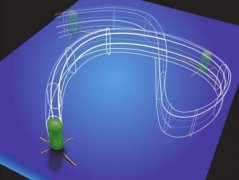
(Click Image for credit)
Microbiologists have already shown that bacteria can swim through liquid using their amazingly well-designed flagella. They have also found that bacteria can crawl along a surface. However, no one had ever caught them in the act of walking until a team of UCLA researchers started studying the dynamics of bacterial biofilms.
The researchers were studying Pseudomonas aeruginosa, a species of bacterium found in soil, water, and many human-made environments. It can cause lung, skin, eye, and gastrointestinal infections. Like many bacteria, members of the species can exist as either free-swimming individuals or surface-clinging colonies. The surface-clinging colonies form biofilms.
Interestingly enough, a free-swimming bacterium can be genetically identical to a member of a biofilm. However, because the two different lifestyles have different requirements, some genes are active in the free-swimming bacteria but not in the biofilm bacteria, and vice-versa. This switching on and off of genes produces bacteria that look and behave quite different, even though they have the same genome.
When the UCLA researchers were studying how the biofilm bacteria behave, they determined that many of them were crawling. That wasn’t unusual. However, they also determined that many of them were “walking!” Bacteria have tiny “hairs” called pili, and many of the biofilm bacteria were able to splay out a few pili on one end and then orient themselves vertically, as show in the drawing above. Twitching one of the pili would then cause the bacterium to move in a given direction.
Why would a bacterium want to “walk” like that? Interestingly enough, because “walking” offers different advantages than “crawling” when it comes to exploring a surface. It’s not that “walking” is better than “crawling” in surface exploration – it’s that each has its advantages. According to the study, “crawling” bacteria moved more effectively in a given direction, while “walking” bacteria were able to move short distances more quickly. Thus, crawling provided better long-range exploration, but walking produced better short-range exploration. In addition, “walking” bacteria more easily detached themselves from the surface.1
This study, of course, just adds more evidence to confirm the creationist view that there is no such thing as a simple organism. Even in bacteria, a given genome can produce vastly different individuals simply by switching on or off some genes. In addition, in a colony, there is a clear division of labor. When it comes to surface exploration, for example, some bacteria take the long-range approach to exploration, while others take the short-range approach. In the end, this produces the most efficient colony. God’s creation is amazingly complex, even when it comes to His single-celled prokaryotic organisms!
References
1. Maxsim L. Gibiansky, et al., “Bacteria Use Type IV Pili to Walk Upright and Detach from Surfaces,” Science, 330:197, 2010
Return to Text

Hey, have you seen the news from NASA? It seems like it clearly shows that not all life sprang from one common ancestor.
“At its conference today, NASA scientist Felisa Wolfe-Simon will announce that NASA has found a bacteria whose DNA is completely alien to what we know today. Instead of using phosphorus, the bacteria uses arsenic.”
http://www.wired.com/wiredscience/2010/12/nasa-finds-new-life/
~Jonathan
Whoops, ignore my other comment, there is more recent info out now.
http://www.wired.com/wiredscience/2010/12/nasa-finds-arsenic-life-form/#more-43911
It turns out, it wasn’t naturally occurring, instead, the microbe was “force fed” arsenic, and it adjusted to be able to use it in place of the phosphorus.
Thanks, Jonathan. I read the full article on Science Express last night and will write a post about it today.